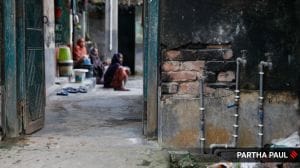Stay updated with the latest - Click here to follow us on Instagram
No rains in sight, Punjab pushes direct sowing
A poor monsoon may lead to a drought-like situation but experts said DSR will save around 50 per cent groundwater and enhance the yield by 10 to 15 per cent.
The Punjab government has shed its reluctance and gone for direct sowing of rice (DSR), a technique that renders transplantation of saplings unnecessary, and leads to saving of water, labour cost and power.
Spurred by an India Meteorological Department (IMD) prediction of a subnormal monsoon and depletion of groundwater in 75 per cent of the administrative blocks in Punjab, the government has set a target of bringing one lakh hectares under DSR.
This is five times the area under DSR in 2012 in the state. Most rice growers have junked DSR, believing it is not successful.
Punjab government did not initially push for DSR mostly because farmers had easy availability of canal water and tubewell connections and electricity subsidy, which is still available. It was a couple of years ago that pressure to decrease the area under paddy, a water-intensive crop, was put on the state government by the Central Ground Water Board (CGWB).
DSR offers the best solution, say experts. “To popularise any new system against the age-old system (traditional paddy sowing) one needs planning, targets, extensive awareness programme and more research,” said a senior officer with the Punjab Farmers Commission..
A poor monsoon may lead to a drought-like situation but experts said DSR will save around 50 per cent groundwater and enhance the yield by 10 to 15 per cent.
A demonstration of the DSR technique has been started by the agriculture department. Suggestions given by farmer Gurdev Singh Khush at the Progressive Punjab Agriculture Summit in February had impressed CM Parkash Singh Badal. Badal reportedly asked Punjab Agriculture department officials to fix a large target for DSR.
Joint director (agriculture) Dr Balwinder Singh Sohal, among the pioneers in state to introduce DSR, said this year one lakh hectares would be under DSR, and the rest will be under the usual pattern.
“Also, the prediction of bad monsoon calls for bringing more areas under DSR,” said Dr Sohal adding the water table in the state has been dipping close to one metre every year. Besides the traditional method of growing paddy, other water-intensive cash crops contribute to the depletion.
“At the summit in February, Gurdev Singh Khush stressed direct sowing to check the water table depletion,” said Dr B S Sidhu, Advisor to the Punjab Farmer Commission. “DSR uses around 50 cent less water,” said Dr Sohal adding there is no need of a ‘nursery’ for saplings of their transplantation.
Traditional method involves transplantation of saplings from the nursery after four weeks. The saplings are kept under three to four inches of water (puddling), to reduce weed growth. This ‘puddle irrigation’ needs a lot of water.
DSR, introduced in Punjab in 2006 by a few agricultural experts, could not even reach one per cent of total area under rice until 2012 when CGWB asked Punjab to decrease area under paddy. Around 20,000 hectares was under DSR in 2012. The target is to take it up by five times in a couple of years.
“We have started demonstrations to educate farmers and are presenting success models,” said agriculture director Dr Mangal Singh Sandhu.
“We will organise a function on DSR to spread awareness apart from camps, and will give incentives to farmers. Punjab Agricultural University (PAU), corporate houses and NGOs are helping us reach out to farmers,” said the director.
Punjab already gives a 50 per cent subsidy to growers who adopt DSR and is considering increasing it, said Dr Gurdial Singh, joint director, Food Security Mission, Punjab.
“I started DSR on two acres in 2006 and now I am doing it on 50 acres and saving 50 per cent water and power, as well as getting around 40 quintals per acre against around 30 to 32 using the traditional method,” said farmer Jaspal Singh Swajpur of Swajpur village in Patiala adding it is not difficult to adopt but just a little alertness is required.
Farmer Rajinder Singh of Hari village near Ludhiana said he started with one acre a few years back and now has DSR on 15 acres. “It give 10 to 15 per cent more yield and saves water and labour cost,” said farmer Gurdeep Singh Grewal of Gaddowal village, adding even the quality of grain is better.
If Punjab brings the entire paddy crop under DSR, only seven lakh tube wells would be needed against the 14 lakh existing in the state, experts say. This can save power worth Rs 2,500 crore, labour cost of Rs 1,340 crore and diesel worth hundreds of crores every year.







